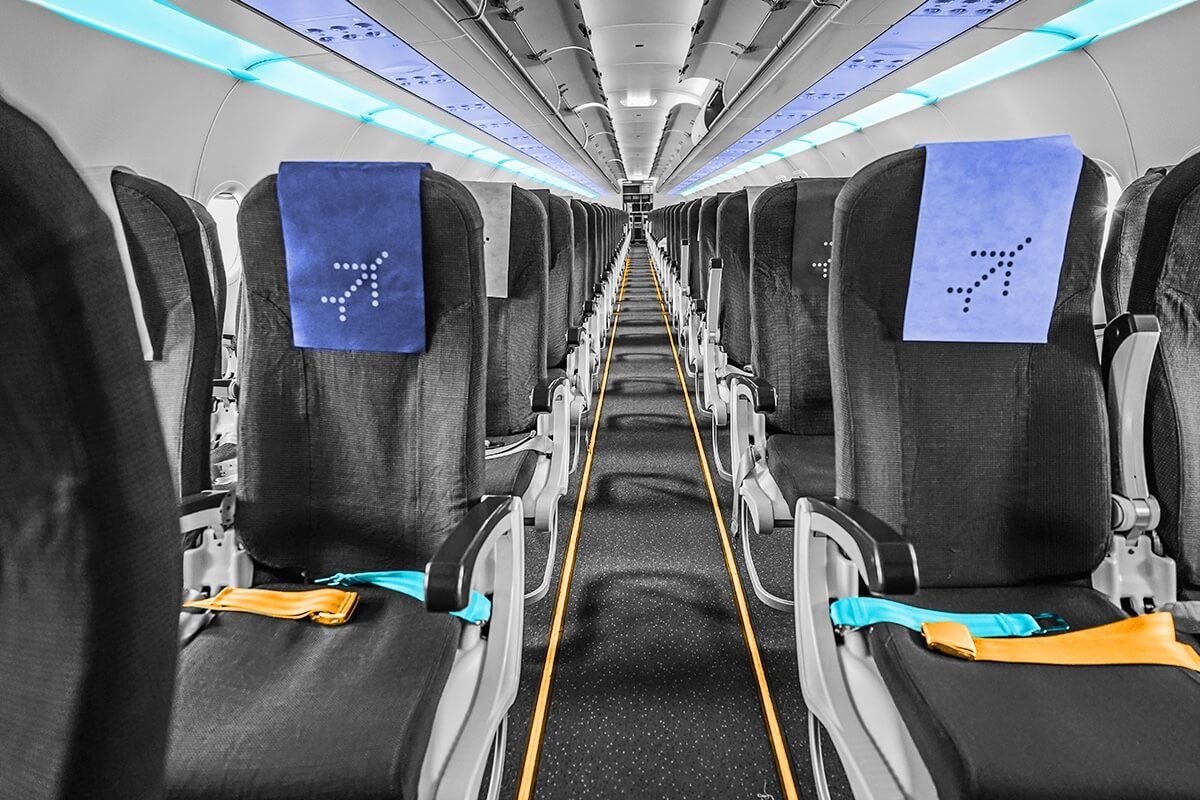

Most features in an airplane cabin are designed for a very specific purpose. However, due to the cabin’s complex design, the flight attendants don’t usually take the time to explain every detail to their passengers. (They're more concerned with making sure everyone is safe and comfortable.) However, if you're a curious person who likes to know how things work, we've got you covered. Here are six things you never knew about airplane cabins.
Cabin Lighting Has a Purpose

Have you noticed that the cabin lights dim during takeoff and landing? It turns out that there are two very good reasons for this. According to Reader's Digest, the first reason is safety. If the lights stayed on and were to suddenly switch from bright to dark in an emergency, it would take precious seconds for passengers' eyes to adjust. With dim lighting during takeoff and landing, our eyes are already adjusted — making it easier to find an exit.
The second reason is the mood. Dim lights are more relaxing than bright lights and might calm a passenger who struggles with flight anxiety. Some airlines such as Virgin Atlantic take this a step further by adding colored lights. Virgin Atlantic uses different shades of their brand color for various situations, like a rosy pink color for boarding and a hot magenta color for drinks.
The Temperature Is Cold for a Reason

Passengers often complain about the cold temperature in airplane cabins. Flight staff will provide passengers with a blanket, but they don't ever increase the heat. That's because the temperature on an aircraft has been set in a very intentional way — and it's for your safety.
A study by ATSM International found that people were more likely to faint on an aircraft than on the ground due to a condition called hypoxia. The pressurized environment of an airplane cabin can prevent our body from getting enough oxygen, which causes fainting. The warmer the temperature onboard the aircraft, the more likely this is to happen. To prevent passengers from passing out, airlines intentionally lower the cabin temperature. While this might be slightly uncomfortable, it's much safer for your body.
The Air Is Cleaner Than You Think

A common myth about air travel is that you're sharing air — along with germs and food particles — with all the other passengers on board. Gross, right? In reality, airlines do a great job of maintaining clean air quality onboard the aircraft. They actually use a HEPA (High Efficiency Particulate Air) filter system. According to the International Air Transportation Association (IATA), this is the same type of filter used to clean the air in hospital operating rooms. The next time you fly, don’t worry: Cabin air is cleaner than you think.
Bathrooms Can Be Unlocked From the Outside

While there is a lock inside cabin bathrooms for passengers to use, flight attendants also have the ability to quickly unlock the door from the outside as well. According to Aerotime Hub, this is for passenger safety. In the event of an emergency, flight attendants need to be able to access the bathroom without picking the lock or taking the door off its hinges. This is necessary if a passenger has a health scare or needs assistance while in the bathroom. It can also be used for children who are unable to unlock the door themselves. Don't worry, though: A flight attendant would never just open the door for no reason. They respect passenger privacy and would only use the unlock option in an emergency.
Window Blinds Must Remain Open

During takeoff and landing, most flight attendants will ask that passengers lift their window blinds. Like so many other things on an airplane, there's a real reason for this. Open blinds allow the flight staff to see any issues on the ground or on the airplane itself. Passengers might also report unusual circumstances they observe from their windows. Lifting the blinds also allows our eyes to adjust to the conditions outside quickly in case of an emergency.
Cabin windows also sometimes have triangle stickers on them to mark certain seats. According to Captain Joe, these stickers indicate which windows provide the best view of the wings. Flight attendants can easily look for the triangle when they need to see the wings for safety reasons. According to Captain Joe, these aisles are also great for passengers prone to motion sickness due to the extra stability provided by the wings.
There's a Secret Handrail

Walking down the aisle of a moving airplane can be a wobbly experience — especially when there's turbulence. Most passengers end up grabbing the seats as they walk, which can disturb the people in those seats, but there's actually a better way.
If you watch the flight attendants, you'll notice that they repeatedly reach up to the ceiling when they walk down the aisle. That's because there's a built-in handle rail along the bottom edge of the storage compartment, which can be used to steady yourself. Next time, copy the flight attendants, avoid aggravating fellow passengers, and use this secret rail instead!
